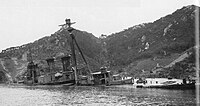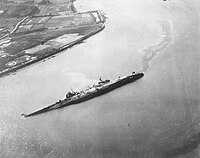Attacks on Kure and the Inland Sea (July 1945)
| Attacks on Kure and the Inland Sea | |
|---|---|
| Part of the Kure and Seto Inland Sea, Japan 34°14′N 132°33′E / 34.23°N 132.55°E | |
| Result | Allied victory |
133 aircraft destroyed[1]
3 battleships sunk
1 ex-battleship sunk
2 heavy cruisers sunk
1 light cruiser sunk
2 armored cruisers sunk
1 destroyer sunk
2 escort ships sunk
1 escort carrier grounded
306 aircraft destroyed
392 aircraft damaged[1]
The attacks on
Prelude
In July 1945 the IJN's remaining large warships were concentrated near the major naval base of Kure. The ships were immobilized by fuel shortages and were being used only as stationary
In his memoirs Admiral
Despite operating as a task group of the US Third Fleet, the British Pacific Fleet was excluded from the attack on Kure because the Americans did not want Britain to claim a part in destroying the Japanese fleet. The BPF was instead used to attack airfields and the port of Osaka.[2][3]
Kure had been subjected to several major attacks prior to July 1945. On 19 March 1945, 321 US Navy aircraft
Participating in the attacks were Task Force 38 for the Americans and Task Force 37 for the British. Task Force 37 included the carriers HMS Formidable (67), Indefatigable (R10), and Victorious (R38).[6]
Battle

The Third Fleet's attack against Kure began on 24 July.
The British Pacific Fleet's attacks against Osaka and targets in the Inland Sea caused the escort carrier Kaiyo to be damaged and grounded, the escort ships No. 4 and No. 30 were also sunk for the loss of four aircraft.[2]

US strikes against Kure resumed on 28 July, damaging the battleships Ise and Haruna and the heavy cruiser Aoba.[2] The aircraft carrier Katsuragi which had largely escaped attack in the earlier raid, and the unserviceable light aircraft carrier Ryūhō were attacked, with Katsuragi suffering heavy damage.[8] These air strikes were among the largest conducted by the US Navy during the war, and were the most destructive of shipping.[8]
On 28 July, the USAAF attacked Kure ships with 79
Allied losses included 102 aircrew and 133 planes lost in combat or accidents during the attacks. These losses were higher than those suffered by the Third Fleet in most of its operations, and were the result of the heavy anti-aircraft defences around Kure.[1]
Aftermath
The Allied attacks on Kure and the inland sea left
Warships sunk or damaged
At Kure
Battleships
- Haruna: Hit by a single bomb which caused light damage on 24 July, hit by eight bombs on 28 July, sunk at her moorings.
- Hyūga: Hit by ten bombs on 24 July, sunk in shallow waters.
- Ise: Damaged by bombs in an attack by 60 planes on 24 July, struck by sixteen bombs on 28 July, sunk in shallow waters.
Aircraft carriers

- Amagi: Hit by two bombs and received several near-misses on 24 July, hit several more times on 28 July, capsized.
- Katsuragi: Hit by one bomb on 24 July which did little damage. Hit by one 2,000-pound bomb on 28 July which blew a large hole in the flight deck, moderately damaged.
- Hōshō: Slightly damaged by a single bomb or aerial rocket hit on 24 July.
- Ryūhō: Already severely damaged in the March air raid on Kure, attacked again on 24 and 28 July but remained afloat.
Cruisers
- Iwate: Not hit by any bombs, but three near misses on 24 July caused Iwate to sink in shallow water the following day.
- Izumo: Not hit by any bombs, but three near misses on 28 July caused Izumo to capsize.
- Aoba: Bombed and sunk on 24 July, hit by four more bombs and caught fire on 28 July.
- Tone: Hit by three bombs and sunk on 24 July, attacked again on 28 July by rockets and bombs.
- Kitakami: Damaged by strafing on 24 July.
- Ōyodo: Strafed and hit by five bombs on 24 July, near-missed by bombs on 28 July and capsized.
- Yakumo: Damaged and re-designated as a transport ship.
Destroyers
- Yoizuki: Slightly damaged on 24 July.
- Nashi: Sunk on 28 July 1945.
- Kaba: Damaged on 24 July.
- Asagao: Damaged on 28 July.
Unfinished ships
- Aso: Unryū-class aircraft carrier, attacked on 24 July, caught fire.
- I-404: I-400-class submarine, severely damaged on 28 July, scuttled.

- Settsu: Ex-battleship, grounded after one bomb hit and five near-misses on 24 July, hit by two bombs on 28 July. (Hiroshima Bay, Etajimacho Ozu)
- Kaiyō: Escort carrier, attacked on 24 and 28 July, damaged and grounded. (Beppu Bay, Oita)
- Komahashi: Submarine tender, attacked on 27 July and sunk in shallow water. (Owase Port, Mie)
- I-205: Unfinished I-201-class submarine, sunk on 28 July. (Kurahashi Island)
- Hagi: Matsu-class destroyer, damaged on 28 July. (south of Iwaishima, Yamaguchi)
- Tsubaki: Moderately damaged on 24 July. (off the coast of Okayama)
- Escort ship No. 4: Sunk on 28 July. (off the coast of Toba, Mie)
- Escort ship No. 30: Sunk on 28 July. (off the coast of Yura, Wakayama)
Gallery of major warships sunk in the attack
-
Amagi capsized in Kure harbor, 1946
-
Bombed out wreck of Hyuga sunk in shallow waters of Hiroshima Bay, 1945
-
Ise, sunk in Ondo-no-seto strait, October 1945
-
Heavily damaged Haruna sunk at her moorings in Kure harbor, October 1945.
-
Settsu grounded at Etajima, October 1945
-
Oyodo capsized in shallow waters, 28 July 1945
-
Aoba sunk in harbor, October 1945
-
Tone sunk in Etajima Bay, 29 July 1945
References
Notes
- ^ a b c Halsey (1947). Admiral Halsey's Story. p. 264.
- ^ a b c d e Royal Navy 1995, p. 223
- ^ a b c Halsey 1947, p. 265
- ^ Tillman 2010, pp. 128–132.
- ^ Craven & Cate 1953, pp. 649, 668–669, 675
- ^ a b c Rohwer 2005, p. 424
- ^ Potter 1985, p. 345
- ^ a b c Morison 2002, p. 331
- ^ Craven & Cate 1953, p. 698
- ^ Roskill 1961, p. 374
- ^ Frank 1999, p. 158
Bibliography
- Craven, Wesley; Cate, James (1953). The Pacific: Matterhorn to Nagasaki. The Army Air Forces in World War II. Chicago: University of Chicago Press.
- Frank, Richard B. (1999). Downfall. The End of the Imperial Japanese Empire. New York: Random House. ISBN 978-0-679-41424-7.
- Halsey, William F.; Bryan, J. (1947). Admiral Halsey's Story. London: Whittlesey House.
- Morison, Samuel Eliot (2002) [1960]. Victory in the Pacific. History of United States Naval Operations in World War II. Champaign: University of Illinois. ISBN 0-252-07065-8.
- Potter, E.B. (1985). Bull Halsey. Annapolis, Maryland: Naval Institute Press. ISBN 978-1-59114-691-9.
- ISBN 1-59114-119-2.
- Roskill, Stephen W. (1961). "Part II 1st June 1944 – 14th August 1945". The War at Sea 1939–1945. History of the Second World War. Vol. III The Offensive. London: Her Majesty's Stationery Office.
- Royal Navy (1995). War with Japan. Vol. VI Advance to Japan. London: HMSO. ISBN 0-11-772821-7.
- Tillman, Barrett (2010). Whirlwind: The Air War Against Japan 1942–1945. New York: Simon & Schuster. ISBN 9781416584407.
External links
 Media related to Bombing of Kure at Wikimedia Commons
Media related to Bombing of Kure at Wikimedia Commons








